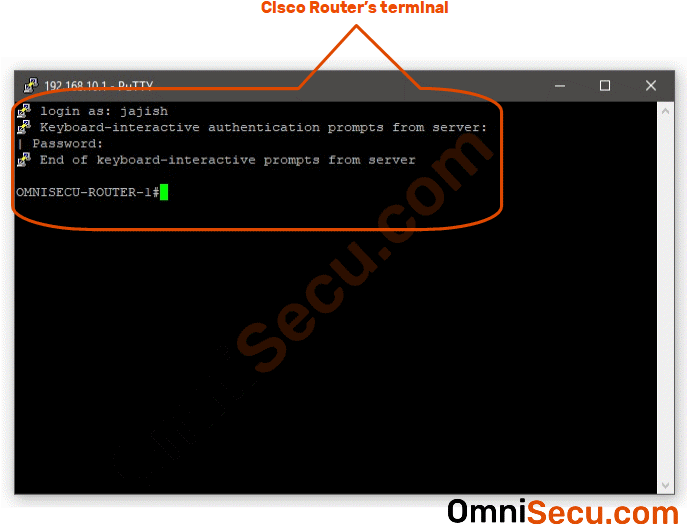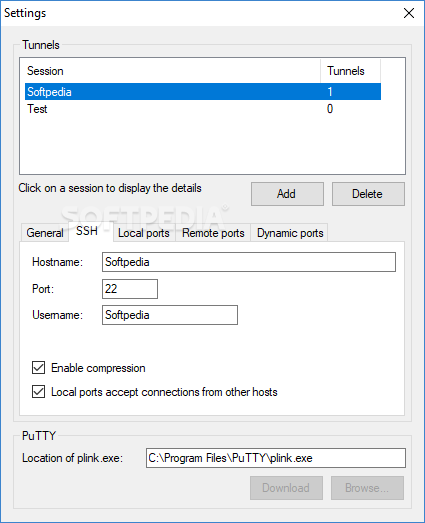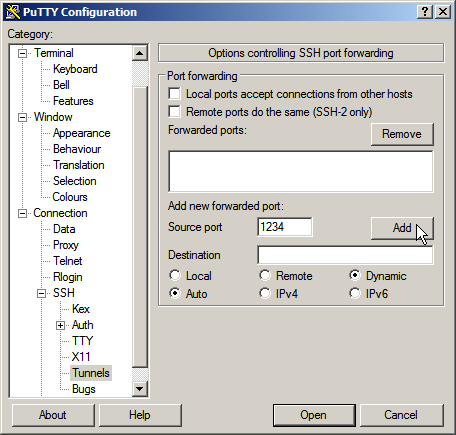

If you need to start a graphical application (for example, from a database server) and the output should be displayed on your local PC, then you must activate X11 forwarding in PUTTY. Tada! That was (relatively) pain free! Step 4 (Conditional) - Enable X11 forwarding

Once your machine is connected, we can now go to and be greeted with the apache default landing page Make as many rules as you need to in the same way.

Then, add your Destination address of your RONIN machine and application portįor this example, we're using Apache, and wanting to connect to port 80 We will also assume you've already added your SSH key to the config in PuTTY as described in this article Lets get started Step 1 - Add a port forwarding rule to your connectionĮnter your source port (your local machine port you want to forward)įor this example, we're forwarding port 1234
Putty create ssh tunnel install#
So for this we will install an apache server on a machine called Step 4: Configuring Your System Software. We suggest you read our previous article on port forwarding for a detailed understanding of what Port Forwarding / Tunnelling achieves.Īgain, we will need an example to explain what we are doing. If you haven’t done so, start by creating the SSH gateway server and save it on your system. No, you can't just use regular ssh commands for some reason (who knew?!) into the SOCKS row and click OK.Now that you've connected to your machine with PuTTY you may be wondering how you might create a secure SSH tunnel to your application with PuTTY. In both cases you need to enable “Use a proxy server for your LAN” and then click Advanced. Wrench > Options > Under the Hood (Bonnet) > Change Proxy Settings > LAN Settings. Your tunnel will receive this traffic and forward it on to the server it is connected to. This will force all traffic through port 8080 on your local machine, which is the same port your SSH tunnel is listening on. Make sure SOCKS v5 is selected, and then click OK.
Putty create ssh tunnel manual#
select Manual proxy configuration and then add 127.0.0.1 and port 8080 to the SOCKS Host. In Preferences > Advanced > Network > Settings. Sending Traffic through your Tunnel Firefox N: Do not execute a remote command (doesn't open the shell).n: Redirects stdin from /dev/null (actually, prevents reading from stdin).2: Forces ssh to try protocol version 2 only.Some of the more useful flags you can use are -C2qTnN, which have the following affects: Open Terminal or Console and run the following command: $ ssh -D 8080 Į would be the URL of the machine you're trying to connect to (it could also be an IP address). Click Add and D8080 will appear in the Forwarded Ports list. Enter 8080 in the Source Port box and select the Dynamic radio button. Once you have a server and an account, open PuTTY and go to Connection > SSH > Tunnels. This could be a home server, company server, or one you rent from a server hosting company. In order to create your tunnel, you'll need an external server to connect to. So if you want your traffic to look like it originates from a different location, then this is one way to do it.įor example, certain shows on Netflix can't be shown in the United States for contractual reasons, so traffic tunneling/proxies are used to get around these restrictions. So why would you ever want to do this? By tunneling your traffic, you're basically using the destination computer/server as a proxy server.

Putty create ssh tunnel how to#
In this case, we'll show you how to send your browser traffic over the SSH protocol. Tunneling your traffic is the process of sending data, like HTTP, over a different protocol.


 0 kommentar(er)
0 kommentar(er)
